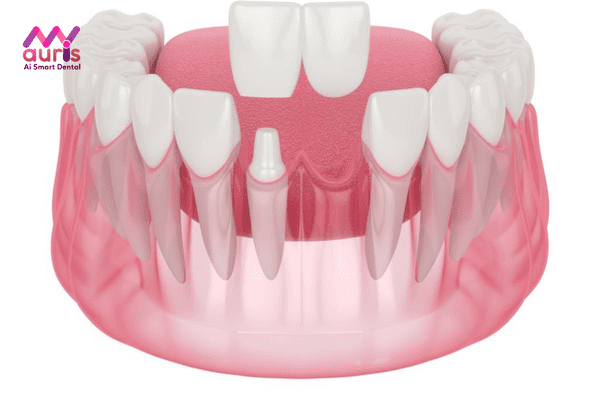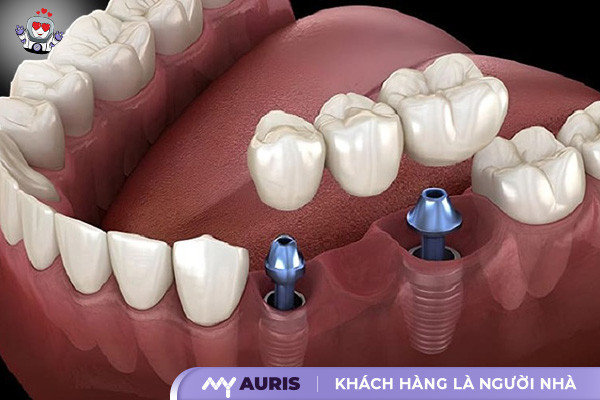Ceramic dental bridges are increasingly popular thanks to their ability to restore their original shape, improve chewing and swallowing function and increase confidence for those with dental problems. However, many people wonder: Does porcelain dental bridge hurt?
What is a porcelain dental bridge?
Ceramic dental bridge, also known as dental implant bridge, is a popular method to permanently restore missing teeth, ensuring both chewing function and aesthetics. This technique works based on the principle of using the teeth next to the lost tooth as support, then placing a row of porcelain teeth on top to replace the missing teeth.
The structure of a porcelain bridge usually consists of 2 to 4 porcelain teeth attached together. In particular, the two teeth next to the tooth loss area act as solid supports, helping to ensure long-term durability for the bridge. Porcelain teeth are meticulously crafted with colors similar to real teeth, bringing high aesthetics and harmony with the face.

Types of ceramic dental bridges popular today
Ceramic dental bridge is a fixed restoration method that helps replace missing teeth, brings high aesthetics and restores the ability to chew. Currently, there are three popular types of porcelain dental bridges including: traditional porcelain dental bridges, veneered porcelain dental bridges and jumping porcelain dental bridges.

Traditional ceramic dental bridge
Ceramic dental bridge Traditional is the most widely applied method. To do this, the doctor will grind the teeth on the abutment teeth, helping to create enough space for the porcelain crown to be attached on top. The dental bridge will consist of a row of connected porcelain crowns, replacing the space lost by teeth. This method is suitable for cases where one or more teeth are lost in a row, helping to ensure good chewing function and high durability.

Placed Porcelain Dental Bridge
Placed porcelain dental bridges have the outstanding advantage of not requiring tooth grinding, helping to preserve natural teeth as much as possible. This method is often applied to the front teeth area, especially for young patients or those who want to protect tooth enamel. Veneers are made of metal or thin porcelain, fixed to the abutment teeth on both sides of the missing tooth space with dental cement, firmly holding the denture in the middle. However, this bridge requires the abutment teeth to be healthy and suitable for areas with little chewing force.

Jumping ceramic bridge
Jumping porcelain bridge is a variation of traditional porcelain dental bridges, often used for front teeth and lateral incisors, because these positions are less exposed to chewing force than molars. The main difference is that the porcelain crown is only supported by the abutment tooth on one side instead of both sides of the missing tooth space. This method helps preserve more tooth tissue but is only suitable for cases where a single tooth is lost in an esthetic area.

Process of making Porcelain dental bridges at My Auris dentistry
At My Auris dentistry, the process of making porcelain dental bridges is carried out methodically, ensuring accuracy and high aesthetics. The specific steps are as follows:
Dental examination and examination
The doctor conducts a general examination to evaluate the oral condition. At the same time, X-rays help determine the jaw bone structure and the number of teeth that need restoration. Based on the examination results, the doctor will develop the most detailed and appropriate treatment plan for the patient.
Anesthesia and tooth pulp grinding
Before grinding the tooth stump, the patient will be anesthetized to reduce pain and create a feeling of comfort during the procedure. After that, the doctor will grind the tooth stump at a standard rate, ensuring not too much damage to the real tooth, and at the same time creating a solid foundation for attaching the crown.
Taking impressions of the jaw and restoring temporary teeth
After completing the tooth preparation process, the doctor will take an accurate impression of the jaw and send it to the lab to make porcelain teeth. While waiting for the crown to be completed, the patient will be attached Temporary crowns to maintain aesthetics and protect tooth pulp.
Attaching the porcelain bridge
When the porcelain crown is complete, the doctor will proceed to attach the porcelain bridge to the tooth post Check carefully to make sure the crown fits tightly to the tooth abutment, does not cause bite misalignment or discomfort when chewing.
Check and make a re-examination appointment
After completion When attaching a porcelain bridge, the doctor will do a final check to ensure durability and stability when used. At the same time, the patient will be scheduled for regular dental check-ups to monitor the condition of the restoration, ensuring long-term effectiveness.
Are porcelain bridges durable?
Ceramic dental bridges have the same hardness and chewing ability as real teeth, helping to ensure good chewing function. The durability of porcelain teeth usually lasts from 7 to 10 years, even longer if properly cared for. However, the specific usage time depends on many factors such as the bridge material, oral hygiene methods, diet and the doctor’s skills. Currently, all-ceramic teeth have a longer lifespan than metal-ceramic teeth thanks to their better load-bearing capacity and biological compatibility. Therefore, to prolong the durability of ceramic dental bridges, it is necessary to maintain scientific oral care habits and regular dental check-ups.

Is porcelain dental bridge painful?
Many people are concerned about whether porcelain dental bridge is painful? According to dental experts, this process is usually not painful if done correctly. However, discomfort can occur appears during the grinding process, especially if the tooth is too much invaded or touches the pulp. If the doctor controls the grinding operation well,Without deep impact on real teeth, the risk of pain is almost non-existent.
Some cases with sensitive teeth may experience sensitivity for 2-3 days after making a porcelain bridge. This is a normal reaction of the body and will gradually decrease over time, so patients do not need to worry too much. To ensure that the porcelain bridge implant process goes smoothly and without causing pain, choosing a reputable dentist is an important factor.
At dentists with a team of skilled doctors and modern equipment, the treatment process is faster and more accurate, helping patients feel comfortable and stress-free. Thanks to the support of advanced technology, the pulp grinding process is well controlled, minimizing invasion of real teeth, reducing the risk of pain and sensitivity after treatment.
Why does making a porcelain bridge cause prolonged toothache?
Normally, after grinding teeth to make a porcelain bridge, the feeling of sensitivity only lasts for about an hour. weeks and tends to improve. This is a normal reaction of the body. However, if the toothache persists and becomes increasingly severe, especially when eating and drinking, you need to go to the dentist immediately for a check-up. Below are the main causes that can cause this condition:
Excessive grinding exposes the dentin
Excessive grinding beyond the standard can cause the dentin layer to become damaged. exposed, causing a lasting feeling of sensitivity. If the Doctor does not have a lot of experience or uses the wrong technique, the tooth enamel is too damaged and will make the teeth sensitive and susceptible to pain when exposed to hot or cold temperatures or when chewing.
Improper bite causes pressure on the jaw bone
After attaching a porcelain bridge, if the bite is not adjusted properly, the pressure on the jawbone will increase, causing pain and discomfort. If this condition persists, surrounding teeth can also be affected, leading to widespread pain.
Tooth decay under the porcelain bridge
Even though the porcelain bridge is attached with dental glue Specialized and antibacterial, but if this glue layer is exposed or the porcelain tooth is cracked, bacteria can enter and cause tooth decay. This condition not only causes pain but also affects the durability of the porcelain bridge.
Pulpitis is not thoroughly treated
If before making the bridge Porcelain, teeth with pulpitis but not treated thoroughly, pulpitis cCan cause necrosis, spread and nerve irritation. This causes intense and prolonged pain, seriously affecting oral health.
The restoration technique is not guaranteed
If the restoration technique is not correct In fact, the abutment teeth may have exposed roots and may not fit tightly with the gum tissue. This condition leads to receding gums, exposing tooth roots and causing damage to periodontal tissue. If not intervened promptly, it can lead to jaw bone loss, loose teeth or even loss of abutment teeth.
Making a porcelain bridge is an optimal dental restoration method, effective and safe for those who unfortunately have lost teeth. This solution not only helps restore tooth function but also brings confidence in daily communication. When performed by an experienced doctor with a guaranteed procedure, making a porcelain bridge is completely painless. Furthermore, proper care after the procedure also plays an important role in maintaining long-term results. With outstanding benefits, porcelain dental bridges are becoming the top choice to improve oral health and quality of life.





